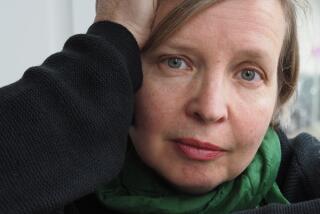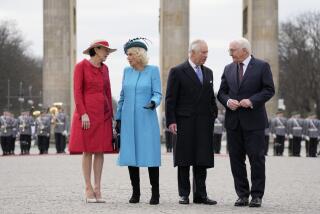The Green Canals of the Spreewald
- Share via
BURG, Germany — “We don’t distract our passengers here as they do on the Grand Canal in Venice,” boasted Wilfried Lusche, our voluble gondolier, as he maneuvered my husband and me gently along a narrow offshoot of the Spree River in eastern Germany.
The waterway, often no wider than 8 feet, was overhung with canopies of weeping willows, poplars and birches and lined with sunflowers, asters and thick ferns. Occasionally a leaping frog rippled the water.
“Here the water is quite clean. It doesn’t smell bad, either,” Lusche continued, warming to his theme. “Why disturb you with our singing? The birds’ chirping and the insects’ buzzing is much more entertaining than our serenades.” With that he fell silent, and the world fell away.
We were in the Spreewald (Spree Forest), an area unknown to most foreigners before the unification of Germany but hugely popular with day-trippers from Berlin. We were persuaded to visit last summer by a German friend who touted the region’s quiet beauty and the legendary joys of a Spree Kahnfahrt (boat ride), the area’s oldest attraction.
The Spreewald is 65 miles south of Berlin and about the same distance north of Dresden. With plans to visit both cities, we booked a stopover here.
It turned out to be more than a relaxing respite from the hectic pace and building frenzy of Berlin. It was a detour into an unspoiled world of shimmering waterways, lush greenery, dense forests and charming towns where life still moves at a 19th century pace.
In our four days of exploring, we encountered rare dragonflies, butterflies and black storks as well as unique orchids and waterlilies. We visited a castle and a museum dedicated to pickled cucumbers, and we learned a bit about the Sorbs, Germany’s only indigenous ethnic minority, who cling to the customs of their Slavic origins.
We oriented ourselves on our drive down from Berlin with a stop at the 1918 Bismarck Tower in Burg, a few miles off the Autobahn exit. The view from the 100-foot monument’s observation roof was beautiful--myriad streams snaking around farms, villages, meadows and forests.
In addition to a room in the Romantik (that’s the name of a chain, not a descriptive) Hotel Zur Bleiche in Burg, we had booked the services of a boatman for an afternoon solo ride. Wilfried met us at the hotel’s boat landing with his Kahn (barge), a long, black, flat-bellied craft built to accommodate 12 passengers. The seats were covered with bright plaid cushions, and small bouquets graced the narrow tables between the benches. One of the tables was set for coffee and cake for two. Wilfried, in white shirt, black vest and pants, manned the tall upright oar from the rear.
Our four-hour ride took us on the main canal at Burg through several narrow connecting waterways, which sometimes ran along the backyards of houses, other times through emerald meadows and fields dotted with onion-shaped haystacks. Much of the way, we floated beneath sun-dappled, filigreed arches of birches and alders. It was like being inside a leafy Corot painting.
Here and there we had intimate glimpses of rural life. Ancient, paint-thirsty wooden houses with thatched roofs rubbed eaves with modern balconied dwellings. Waterside flower and vegetable gardens abounded. Colorful laundry billowed on a line in front of a red-shuttered farmhouse. A crowing rooster strutted toward us with his entourage of hens and a lone turkey. A whooping gaggle of teenagers stopped playing soccer just long enough for two of the lads to man the first of several locks we traversed.
Persuading our gondolier to break his pledge of silence during the ride wasn’t difficult. (My husband, Bill, and I are German-speakers, but English-speakers shouldn’t have a problem; many locals we encountered knew some English.) “We have 990 kilometers [620 miles] of waterways in this area,” Wilfried volunteered, “and about 540 kilometers [340 miles] of these are navigable.” Communities are linked by hundreds of little bridges, most of them wooden with a high arch just tall enough for a standing boatman.
Now in his early 30s, Wilfried has been a ferryman since he was 14. “Our tourist traffic has improved greatly since communist times,” he said. In the heyday of the German Democratic Republic, before unification in 1990, the government sent workers here on vacation--as many as a million a year in a country of 17 million. “Now we see other Europeans--Scandinavians, Russians, even French people and of course ‘Wessies’ [from the former West Germany]. You are my first Americans, but I ferried some Australians around last year.”
The Zur Bleiche hotel sits on a large emerald estate outside town. After a swim in the hotel pool, we relaxed in the glass-enclosed solarium until it was time to dress for dinner.
Our room--a long and narrow attic chamber--was decorated in butter-cream yellow and earthy reds with a smattering of country antiques, and it had a spacious modern bath. It overlooked the front lawn, where deck chairs sat around a pretty weeping willow.
The Spree River meanders through the eastern corner of Germany between the mountainous Czech border and Berlin. Around the city of Cottbus, the river branches into a dense maze of streams, ponds, ditches and riverine woods resembling a bayou. Until the advent of roads it was almost impregnable and little known by outsiders.
This natural fortress is what attracted western Slavic tribes known as Sorbs, or Wenden, to settle between the 6th and 8th centuries. The isolation allowed the Sorbs to maintain their culture and language through the centuries--with the exception of the Third Reich years, when Sorbian was forbidden.
Though the Sorbs’ constitutional rights are now protected by law, their language is largely present in Spreewald only in the bilingual local signs: Burg is Bujokowsy; Lubbenau, Lubnjow; Cottbus, Chuzebuz. The majority of the estimated 40,000 people who speak Sorbian live around Bautzen in the neighboring state of Saxony.
We visited Cottbus the day after our Kahnfahrt. The town’s broad main street, devoid of traffic save for several pre-World War II streetcars, recalled East Germany before the Berlin Wall fell. So did the surrounding dismal communist-era cement housing. But a few blocks away we found the Altmarkt (Old Market), where lovingly restored, pastel-colored houses with Baroque gables stood alongside classical 19th century homes of white walls and red roofs. One of the gabled buildings housed Lowe’s Apotheke, a pharmacy founded in 1573 that still sells herbal medicines and the like. In back was a little museum housing antique pharmacy equipment.
The area defined as the Spreewald is roughly 50 miles long, divided into Upper and Lower Spreewald between the towns of Lubben and Lubbenau.
In contrast to our serene boat ride in Burg, we found Lubbenau teeming with sturdy Teutonic-looking tourists. Women in traditional Sorbian costumes--full-skirted long dresses bordered with colorful embroidered flowers, lacy aprons, bright shawls and starched linen headdresses--chatted with the gondoliers directing the passenger traffic.
Women in Sorbian garb also worked in the harbor-side stalls selling various types of Gurken (pickled cucumbers), the local specialty. (A pickle is the mascot on the Spreewald Web site; see Guidebook.) After sampling quite a few varieties, Bill, a pickle devotee, settled on the mustard-marinated Gurken as his favorite.
The Spreewald was declared a UNESCO Biosphere Reserve in 1991 to protect its indigenous wildlife and plants.
A 1 1/2-mile nature path runs between Lubbenau and the lagoon town of Lehde, and it proved to be a satisfying walk. We passed thriving willow groves and clusters of bristly stinging nettles. Frogs croaked, birds trilled and rare wedge-shaped Keiljungfer (Old Maid) dragonflies buzzed by us--rewarding signs of the Biosphere Reserve’s efficacy.
Our destination was Lehde’s open-air museum, where a collection of original rural buildings depicts Sorbian life in the 18th and 19th centuries. The guide drew our attention to the huge four-poster in the corner of a low-ceilinged one-room house. According to local custom, she said, three generations--as many as eight family members--slept together in the bed. Only newlyweds were permitted to bed down separately--on straw in front of the fireplace. Such cramped quarters! No wonder the elders in the photos on the wall above looked less than happy.
We had our last Spreewald supper under a large skylight in our hotel’s romantically candle-lighted dining room. The special menu was printed for “The Fremont Family,” and the four-course meal featured baked perch with braised cucumbers and cottage cheese dumplings. “The perch was probably caught less than three miles from here,” our waitress said with pride.
At one point in the meal she reminisced about the days when “deserving members of the workers’ unions” enjoyed the beauty of a Spreewald that the world is now discovering.
As with so many things that have changed since 1990, we agreed that a Spreewald open to the world might be a mixed blessing. We left with a prayer that its beauty and charm will remain as unique as its primeval landscape.
(BEGIN TEXT OF INFOBOX / INFOGRAPHIC)
GUIDEBOOK
On a Spree in Spreewald
Getting there: Flights from Los Angeles to Berlin--on Lufthansa, British Airways, KLM and Air France--require one plane change. Restricted round-trip fares begin at $833 until June 15, rising to $1,050 for summer travel.
Trains for Lubbenau depart hourly from the Zoo station in the western part of Berlin, or from the Friedrichstrasse station in the east. Round-trip fare: about $21. By car take the Autobahn A13 toward Dresden and exit at Vetschau.
Getting around: Boat operate from most Spreewald harbors, including Lubben, Lubbenau and Burg. Boats leave when full. A boat with tables averages $2.60 per person per hour.
Where to stay: The Romantik Hotel Zur Bleiche in Burg has 79 rooms, a spa and five restaurants. Boat rides can be booked at the hotel’s own dock. Doubles including breakfast buffet and dinner, $180; without meals, $130. Telephone 011-49-35603-620, fax 011-49-35603-60292, Internet https://www.snafu.de/ ~ hotelzurbleiche.
Hotel Schloss Lubbenau, in a castle. Doubles with breakfast, $380. Tel. 011-49-3542-8730, fax 011-49-3542-873-666.
Hotelanlage Starick in Lehde. Doubles, $99 with breakfast. Tel. 011-49-3542-89990, fax 011-49-3542-899910.
For more information: Spreewald Fremdenverkehrsverein, tel. 011-49-3542-3668, fax 011-49-3542-46770, Internet https://www.spreewald-online.de..
German National Tourist Office, 122 E. 42nd St., New York, NY 10168; tel. (212) 661-7200, Internet https://www.germany/tourism.de.
More to Read
Sign up for The Wild
We’ll help you find the best places to hike, bike and run, as well as the perfect silent spots for meditation and yoga.
You may occasionally receive promotional content from the Los Angeles Times.






